Compliant Learning Resources Version control & document hh: A Certificate III in Early Childhood Education and Care Childrens Health and Safety Version 3.7 Produced 17 September 2018
This assignment requires the completion of an incident report form in a childcare setting, documenting details of the incident, including personal injuries, damage to goods, and response to the incident.
91 Pages23021 Words404 Views
Added on 2023-04-23
Compliant Learning Resources Version control & document hh: A Certificate III in Early Childhood Education and Care Childrens Health and Safety Version 3.7 Produced 17 September 2018
This assignment requires the completion of an incident report form in a childcare setting, documenting details of the incident, including personal injuries, damage to goods, and response to the incident.
Added on 2023-04-23
ShareRelated Documents
1
CHC30113 Certificate III
in Early Childhood Education and
Care
Children’s Health and Safety
Version 3.7 Produced 17 September 2018
Copyright © 2018 Compliant Learning Resources. All rights reserved. No part of this publication may be reproduced or distributed in any
form or by any means, or stored in a database or retrieval system other than pursuant to the terms of the Copyright Act 1968
(Commonwealth), without the prior written permission of
Compliant Learning Resources
Version control & document history
CHC30113 Certificate III
in Early Childhood Education and
Care
Children’s Health and Safety
Version 3.7 Produced 17 September 2018
Copyright © 2018 Compliant Learning Resources. All rights reserved. No part of this publication may be reproduced or distributed in any
form or by any means, or stored in a database or retrieval system other than pursuant to the terms of the Copyright Act 1968
(Commonwealth), without the prior written permission of
Compliant Learning Resources
Version control & document history
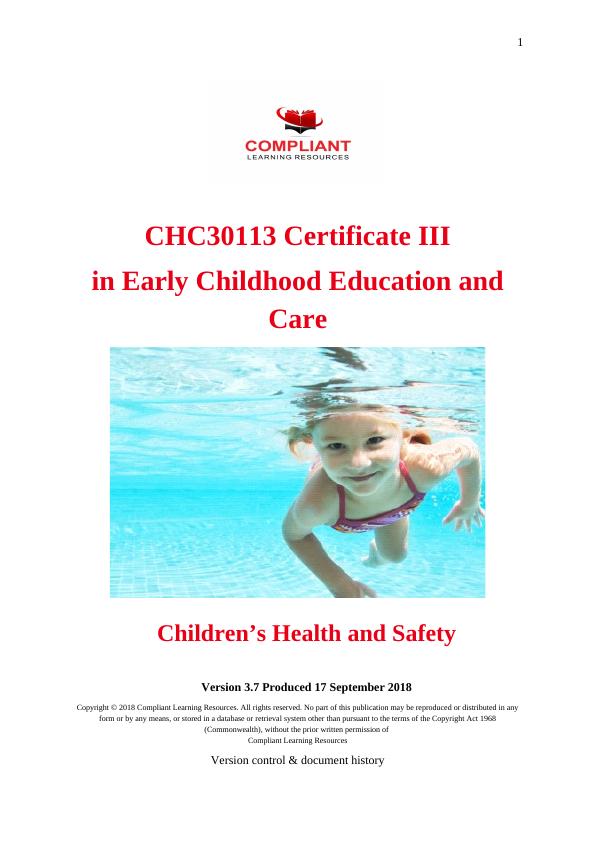
2
Date Summary of modifications made Version
9 December 2013 Version 1 final produced following
assessment validation. 1.0
16 April 2014
Changes to wording and clarification of
benchmarks in questions.
A1,A3a,b,A14,A25,B10,C10
1.1
24 October 2014
Minor clarifications in questions A14;
removed B8(a) question similar with
B7(d)
1.2
18 November 2014 Changes made throughout document 1.3
3 December 2014 Significant changes made to document
following validation 2.0
17 April 2015 Minor revisions on Questions B1 and B16 2.1
18 July 2016 Updates made throughout document 2.2
9 August 2016
Included CHCECE016 in the units of
competency of this workbook.
Added assessment items in the Project.
3.0
9 March 2017 Minor changes in formatting and wording
throughout document 3.1
14 March 2017 Updated links throughout the document 3.2
8 January 2018
Made minor revisions to task instructions
and email template in Case Studies – Part
B – Case Study 2
3.3
7 February 2018 Updated Part B Question 8d 3.4
21 May 2018 NQS Updates 3.5
29 May 2018 Updated Meal Template 3.6
17 September 2018 updated Knowledge Assessment Part A
Question 19f 3.7
TABLE OF CONTENTS
This is an interactive table of contents. If you are viewing this document in Acrobat, clicking
on a heading will transfer you to that page. If you have this document open in Word, you will
need to hold down the Control key while clicking for this to work.
Date Summary of modifications made Version
9 December 2013 Version 1 final produced following
assessment validation. 1.0
16 April 2014
Changes to wording and clarification of
benchmarks in questions.
A1,A3a,b,A14,A25,B10,C10
1.1
24 October 2014
Minor clarifications in questions A14;
removed B8(a) question similar with
B7(d)
1.2
18 November 2014 Changes made throughout document 1.3
3 December 2014 Significant changes made to document
following validation 2.0
17 April 2015 Minor revisions on Questions B1 and B16 2.1
18 July 2016 Updates made throughout document 2.2
9 August 2016
Included CHCECE016 in the units of
competency of this workbook.
Added assessment items in the Project.
3.0
9 March 2017 Minor changes in formatting and wording
throughout document 3.1
14 March 2017 Updated links throughout the document 3.2
8 January 2018
Made minor revisions to task instructions
and email template in Case Studies – Part
B – Case Study 2
3.3
7 February 2018 Updated Part B Question 8d 3.4
21 May 2018 NQS Updates 3.5
29 May 2018 Updated Meal Template 3.6
17 September 2018 updated Knowledge Assessment Part A
Question 19f 3.7
TABLE OF CONTENTS
This is an interactive table of contents. If you are viewing this document in Acrobat, clicking
on a heading will transfer you to that page. If you have this document open in Word, you will
need to hold down the Control key while clicking for this to work.
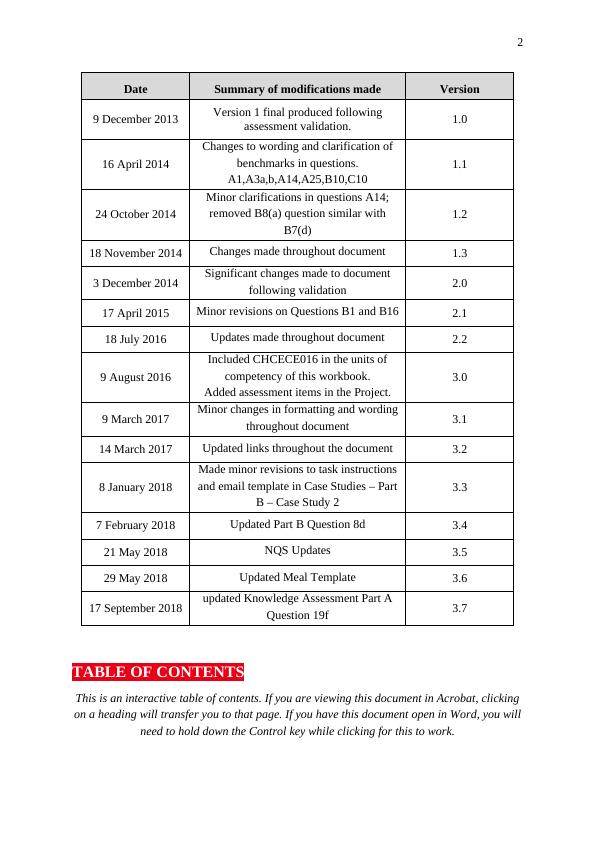
3
INSTRUCTIONS
The questions in the Knowledge Assessment are all in a short answer format. They address
the underpinning knowledge and concepts relevant to the units of competency in this subject.
Case Studies are longer questions requiring creative thought processes and application of
concepts to theoretical situations, while the Project sets out tasks to be delivered in an actual
workplace setting.
Where applicable, you must answer all questions using your own words. However you
may reference your learner guide, and other online or hard copy resources to complete this
assessment.
You must attempt all assessments satisfactorily to achieve an overall award of competent.
Re-read the section on Plagiarism and Copying in your Welcome pack.
If you are currently working as part of an Early Childhood Education/Child Care team, you
may answer these questions based on your own workplace. Otherwise consider what you
should do if you were working as part of an Early Childhood Education/Child Care team you
may refer to Sparkling Stars as an example.
WHAT IS COMPETENCY BASED ASSESSMENT
The features of a competency based assessment system are:
• It is focused on what learners can do and whether it meets the criteria specified by
industry as competency standards.
• Assessment should mirror the environment the learner will encounter in the
workplace.
• Assessment criteria should be clearly stated to the learner at the beginning of the
learning process.
• Assessment should be holistic. That is it aims to assess as many elements and/or
units of competency as is feasible at one time.
• In competency assessment a learner receives one of only two outcomes –
competent or not yet competent.
• The basis of assessment is in applying knowledge for some purpose. In a
competency system, knowledge for the sake of knowledge is seen to be ineffectual
unless it assists a person to perform a task to the level required in the workplace.
• The emphasis in assessment is on assessable outcomes that are clearly stated for
the trainer and learner. Assessable outcomes are tied to the relevant industry
competency standards where these exist. Where such competencies do not exist,
the outcomes are based upon those identified in a training needs analysis.
INSTRUCTIONS
The questions in the Knowledge Assessment are all in a short answer format. They address
the underpinning knowledge and concepts relevant to the units of competency in this subject.
Case Studies are longer questions requiring creative thought processes and application of
concepts to theoretical situations, while the Project sets out tasks to be delivered in an actual
workplace setting.
Where applicable, you must answer all questions using your own words. However you
may reference your learner guide, and other online or hard copy resources to complete this
assessment.
You must attempt all assessments satisfactorily to achieve an overall award of competent.
Re-read the section on Plagiarism and Copying in your Welcome pack.
If you are currently working as part of an Early Childhood Education/Child Care team, you
may answer these questions based on your own workplace. Otherwise consider what you
should do if you were working as part of an Early Childhood Education/Child Care team you
may refer to Sparkling Stars as an example.
WHAT IS COMPETENCY BASED ASSESSMENT
The features of a competency based assessment system are:
• It is focused on what learners can do and whether it meets the criteria specified by
industry as competency standards.
• Assessment should mirror the environment the learner will encounter in the
workplace.
• Assessment criteria should be clearly stated to the learner at the beginning of the
learning process.
• Assessment should be holistic. That is it aims to assess as many elements and/or
units of competency as is feasible at one time.
• In competency assessment a learner receives one of only two outcomes –
competent or not yet competent.
• The basis of assessment is in applying knowledge for some purpose. In a
competency system, knowledge for the sake of knowledge is seen to be ineffectual
unless it assists a person to perform a task to the level required in the workplace.
• The emphasis in assessment is on assessable outcomes that are clearly stated for
the trainer and learner. Assessable outcomes are tied to the relevant industry
competency standards where these exist. Where such competencies do not exist,
the outcomes are based upon those identified in a training needs analysis.
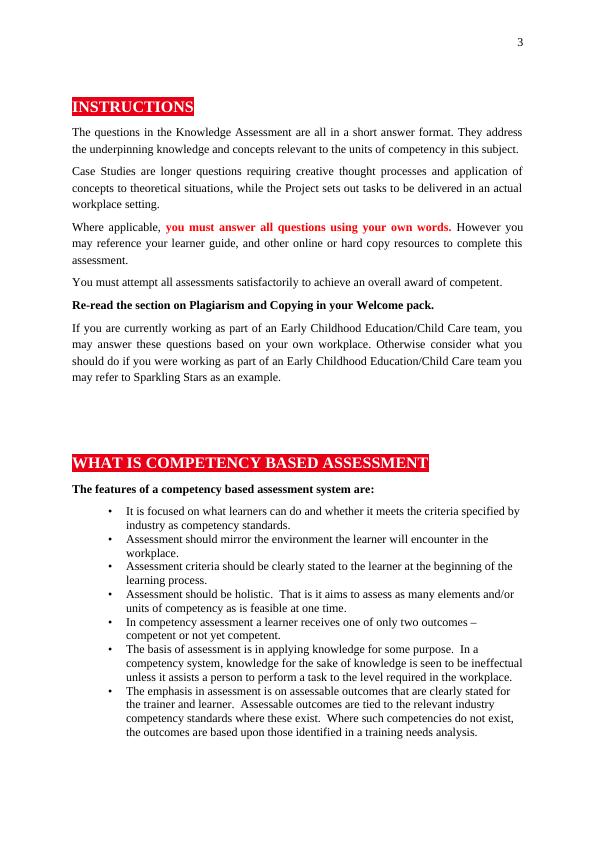
4
Definition of competency
Assessment in this context can be defined as:
• The fair, valid, reliable and flexible gathering and recording of evidence to
support judgement on whether competence has been achieved. Skills and
knowledge (developed either in a structured learning situation, at work, or in some
other context) are assessed against national standards of competence required by
industry, rather than compared with the skills and knowledge of other learners.
THE BASIC PRINCIPLES OF ASSESSING NATIONALLY
RECOGNISED TRAINING
Developing and conducting assessment, in an Australian vocational education and training
context, is founded on a number of basic conventions:
The principles of assessment
• Assessment must be valid
• Assessment must include the full range of skills and knowledge needed to
demonstrate competency.
• Assessment must include the combination of knowledge and skills with
their practical application.
• Assessment, where possible, must include judgements based on evidence
drawn from a number of occasions and across a number of contexts.
• Assessment must be reliable
• Assessment must be reliable and must be regularly reviewed to ensure that
assessors are making decisions in a consistent manner.
• Assessors must be trained in national competency standards for assessors
to ensure reliability.
• Assessment must be flexible
• Assessment, where possible, must cover both the on and off-the-job
components of training within a course.
• Assessment must provide for the recognition of knowledge, skills and
attitudes regardless of how they have been acquired.
• Assessment must be made accessible to learners though a variety of
delivery modes, so they can proceed through modularised training
packages to gain competencies.
• Assessment must be fair and equitable
• Assessment must be equitable to all groups of learners.
• Assessment procedures and criteria must be made clear to all learners
before assessment.
• Assessment must be mutually developed and agreed upon between
assessor and the assessed.
• Assessment must be able to be challenged. Appropriate mechanisms must
be made for reassessment as a result of challenge.
Definition of competency
Assessment in this context can be defined as:
• The fair, valid, reliable and flexible gathering and recording of evidence to
support judgement on whether competence has been achieved. Skills and
knowledge (developed either in a structured learning situation, at work, or in some
other context) are assessed against national standards of competence required by
industry, rather than compared with the skills and knowledge of other learners.
THE BASIC PRINCIPLES OF ASSESSING NATIONALLY
RECOGNISED TRAINING
Developing and conducting assessment, in an Australian vocational education and training
context, is founded on a number of basic conventions:
The principles of assessment
• Assessment must be valid
• Assessment must include the full range of skills and knowledge needed to
demonstrate competency.
• Assessment must include the combination of knowledge and skills with
their practical application.
• Assessment, where possible, must include judgements based on evidence
drawn from a number of occasions and across a number of contexts.
• Assessment must be reliable
• Assessment must be reliable and must be regularly reviewed to ensure that
assessors are making decisions in a consistent manner.
• Assessors must be trained in national competency standards for assessors
to ensure reliability.
• Assessment must be flexible
• Assessment, where possible, must cover both the on and off-the-job
components of training within a course.
• Assessment must provide for the recognition of knowledge, skills and
attitudes regardless of how they have been acquired.
• Assessment must be made accessible to learners though a variety of
delivery modes, so they can proceed through modularised training
packages to gain competencies.
• Assessment must be fair and equitable
• Assessment must be equitable to all groups of learners.
• Assessment procedures and criteria must be made clear to all learners
before assessment.
• Assessment must be mutually developed and agreed upon between
assessor and the assessed.
• Assessment must be able to be challenged. Appropriate mechanisms must
be made for reassessment as a result of challenge.
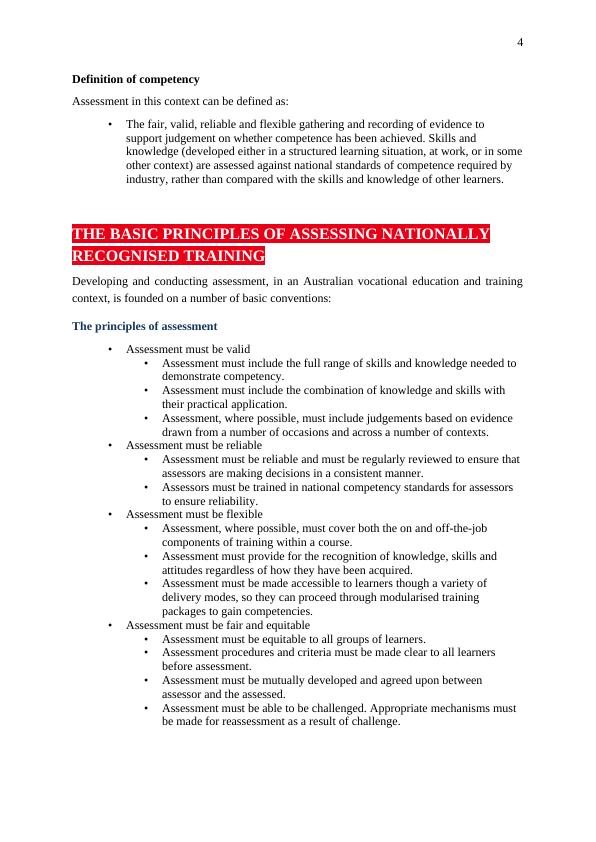
5
The rules of evidence (from Training in Australia by M Tovey, D Lawlor)
When collecting evidence there are certain rules that apply to that evidence. All evidence
must be valid, sufficient, authentic and current;
• Valid
• Evidence gathered should meet the requirements of the unit of
competency. This evidence should match, or at least reflect, the type of
performance that is to be assessed, whether it covers knowledge, skills or
attitudes.
• Sufficient
• This rule relates to the amount of evidence gathered. It is imperative that
enough evidence is gathered to satisfy the requirements that the learner is
competent across all aspects of the unit of competency.
• Authentic
• When evidence is gathered, the assessor must be satisfied that evidence is
the learner’s own work.
• Current
• This relates to the recency of the evidence and whether the evidence
relates to current abilities.
THE DIMENSIONS OF COMPETENCY
The national concept of competency includes all aspects of work performance, and not only
narrow task skills. The four dimensions of competency are:
• Task skills
• Task management skills
• Contingency management skills
• Job role and environment skills
REASONABLE ADJUSTMENT
Adapted Reasonable Adjustment in teaching, learning and assessment for learners with a
disability - November 2010 - Prepared by - Queensland VET Development Centre
Reasonable adjustment in VET is the term applied to modifying the learning environment or
making changes to the training delivered to assist a learner with a disability. A reasonable
adjustment can be as simple as changing classrooms to be closer to amenities, or installing a
particular type of software on a computer for a person with vision impairment.
Why make a reasonable adjustment?
We make reasonable adjustments in VET to make sure that learners with a disability have:
• the same learning opportunities as learners without a disability
The rules of evidence (from Training in Australia by M Tovey, D Lawlor)
When collecting evidence there are certain rules that apply to that evidence. All evidence
must be valid, sufficient, authentic and current;
• Valid
• Evidence gathered should meet the requirements of the unit of
competency. This evidence should match, or at least reflect, the type of
performance that is to be assessed, whether it covers knowledge, skills or
attitudes.
• Sufficient
• This rule relates to the amount of evidence gathered. It is imperative that
enough evidence is gathered to satisfy the requirements that the learner is
competent across all aspects of the unit of competency.
• Authentic
• When evidence is gathered, the assessor must be satisfied that evidence is
the learner’s own work.
• Current
• This relates to the recency of the evidence and whether the evidence
relates to current abilities.
THE DIMENSIONS OF COMPETENCY
The national concept of competency includes all aspects of work performance, and not only
narrow task skills. The four dimensions of competency are:
• Task skills
• Task management skills
• Contingency management skills
• Job role and environment skills
REASONABLE ADJUSTMENT
Adapted Reasonable Adjustment in teaching, learning and assessment for learners with a
disability - November 2010 - Prepared by - Queensland VET Development Centre
Reasonable adjustment in VET is the term applied to modifying the learning environment or
making changes to the training delivered to assist a learner with a disability. A reasonable
adjustment can be as simple as changing classrooms to be closer to amenities, or installing a
particular type of software on a computer for a person with vision impairment.
Why make a reasonable adjustment?
We make reasonable adjustments in VET to make sure that learners with a disability have:
• the same learning opportunities as learners without a disability

6
• the same opportunity to perform and complete assessments as those without a
disability.
Reasonable adjustment applied to participation in teaching, learning and assessment
activities can include:
• customising resources and assessment activities within the training package or
accredited course
• modifying the presentation medium
• learner support
• use of assistive / adaptive technologies
• making information accessible both prior to enrolment and during the course
• monitoring the adjustments to ensure learner needs continue to be met.
Assistive / Adaptive Technologies
Assistive/adaptive technology means ‘software or hardware that has been specifically
designed to assist people with disabilities in carrying out daily activities’ (World Wide Web
Consortium - W3C). It includes screen readers, magnifiers, voice recognition software,
alternative keyboards, devices for grasping, visual alert systems, digital note takers.
IMPORTANT NOTE
Reasonable adjustment made for collecting candidate assessment evidence must not impact
on the standard expected by the workplace, as expressed by the relevant Unit(s) of
Competency. E.g. If the assessment was gathering evidence of the candidates competency in
writing, allowing the candidate to complete the assessment verbally would not be a valid
assessment method. The method of assessment used by any reasonable adjustment must still
meet the competency requirements.
CHEATING AND PLAGIARISM
What is Cheating?
Cheating within the context of the study environment means to dishonestly present an
assessment task or assessment activity as genuinely representing your own understanding of
and/or ability in the subject concerned.
Some examples of cheating are:
• Submitting someone else’s work as your own. Whether you have that persons consent
or not.
• the same opportunity to perform and complete assessments as those without a
disability.
Reasonable adjustment applied to participation in teaching, learning and assessment
activities can include:
• customising resources and assessment activities within the training package or
accredited course
• modifying the presentation medium
• learner support
• use of assistive / adaptive technologies
• making information accessible both prior to enrolment and during the course
• monitoring the adjustments to ensure learner needs continue to be met.
Assistive / Adaptive Technologies
Assistive/adaptive technology means ‘software or hardware that has been specifically
designed to assist people with disabilities in carrying out daily activities’ (World Wide Web
Consortium - W3C). It includes screen readers, magnifiers, voice recognition software,
alternative keyboards, devices for grasping, visual alert systems, digital note takers.
IMPORTANT NOTE
Reasonable adjustment made for collecting candidate assessment evidence must not impact
on the standard expected by the workplace, as expressed by the relevant Unit(s) of
Competency. E.g. If the assessment was gathering evidence of the candidates competency in
writing, allowing the candidate to complete the assessment verbally would not be a valid
assessment method. The method of assessment used by any reasonable adjustment must still
meet the competency requirements.
CHEATING AND PLAGIARISM
What is Cheating?
Cheating within the context of the study environment means to dishonestly present an
assessment task or assessment activity as genuinely representing your own understanding of
and/or ability in the subject concerned.
Some examples of cheating are:
• Submitting someone else’s work as your own. Whether you have that persons consent
or not.
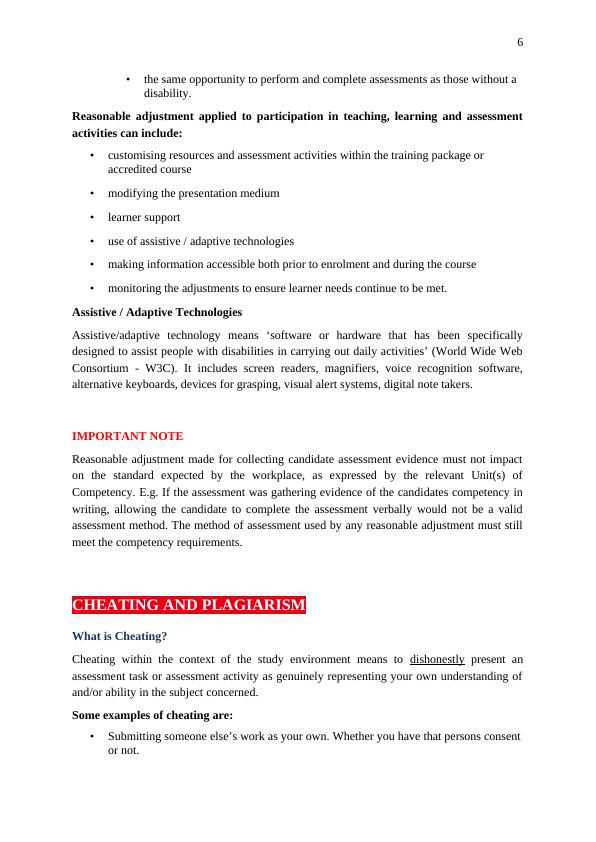
7
• Submitting another author’s work as your own, without proper acknowledgement of
the author.
• To allow someone else to submit your own work as theirs.
• To use any part of someone else’s work without the proper acknowledgement
There are other forms of cheating not contained in this list. These are merely given as some
examples. If you are unsure about whether any particular behaviour would constitute
plagiarism or cheating, check with your trainer prior to submitting your assessment work.
What is Plagiarism?
Plagiarism is a form of cheating and includes presenting another person or organisation’s
ideas or expressions as your own. This includes, however is not limited to: copying written
works such as books or journals, data or images, tables, diagrams, designs, plans,
photographs, film, music, formulae, web sites, and computer programs.
How do I avoid Plagiarism or Cheating?
Students are advised to note the following advice to avoid claims of plagiarism or cheating:
• Always reference other people’s work. You may quote from someone else's work
(for example from websites, textbooks, journals or other published materials) but you
must always indicate the author and source of the material.
• Always reference your sources. You should name sources for any graphs, tables or
specific data, which you include in your assignment.
• You must not copy someone else's work and present it as your own.
• You must not falsify assessment evidence.
THE UNITS OF COMPETENCY
Each unit of competency can be unbundled to reveal two key assessment components:
• the performance criteria
• specifying the required level of performance
• the evidence guide
• Describing the underpinning knowledge and skills that must be demonstrated
to determine competence. It provides essential advice for assessment of the
unit of competency in the form of:
• critical aspects of evidence
• the essential skills
• the essential knowledge
An outline of the units of competency is included below. Note that some skills that are not
able to be observed in the workplace during your Vocational Placement will be assessed
utilising Case Studies and/or projects.
• Submitting another author’s work as your own, without proper acknowledgement of
the author.
• To allow someone else to submit your own work as theirs.
• To use any part of someone else’s work without the proper acknowledgement
There are other forms of cheating not contained in this list. These are merely given as some
examples. If you are unsure about whether any particular behaviour would constitute
plagiarism or cheating, check with your trainer prior to submitting your assessment work.
What is Plagiarism?
Plagiarism is a form of cheating and includes presenting another person or organisation’s
ideas or expressions as your own. This includes, however is not limited to: copying written
works such as books or journals, data or images, tables, diagrams, designs, plans,
photographs, film, music, formulae, web sites, and computer programs.
How do I avoid Plagiarism or Cheating?
Students are advised to note the following advice to avoid claims of plagiarism or cheating:
• Always reference other people’s work. You may quote from someone else's work
(for example from websites, textbooks, journals or other published materials) but you
must always indicate the author and source of the material.
• Always reference your sources. You should name sources for any graphs, tables or
specific data, which you include in your assignment.
• You must not copy someone else's work and present it as your own.
• You must not falsify assessment evidence.
THE UNITS OF COMPETENCY
Each unit of competency can be unbundled to reveal two key assessment components:
• the performance criteria
• specifying the required level of performance
• the evidence guide
• Describing the underpinning knowledge and skills that must be demonstrated
to determine competence. It provides essential advice for assessment of the
unit of competency in the form of:
• critical aspects of evidence
• the essential skills
• the essential knowledge
An outline of the units of competency is included below. Note that some skills that are not
able to be observed in the workplace during your Vocational Placement will be assessed
utilising Case Studies and/or projects.

8
HLTWHS001 - Participate in workplace health and safety
This unit describes the skills and knowledge required for workers to participate in safe work
practices to ensure their own health and safety, and that of others.
• Follow safe work practices
• Implement safe work practices
• Contribute to safe work practices in the workplace
• Reflect on own safe work practices
Foundation Skills
• Reading – in order to accurately read and interpret workplace safety policies and
procedures including safety signs, dangerous goods classifications and safety
instructions
The remaining foundation skills essential to performance are explicit in the performance
criteria of this unit
Performance Evidence
The candidate must show evidence of the ability to complete tasks outlined in elements and
performance criteria of this unit, manage tasks and manage contingencies in the context of
the job role.
There must be demonstrated evidence that the candidate has completed the following tasks at
least once in line with state/territory WHS regulations, relevant codes of practice and
workplace procedures:
• contributed to a WHS meeting or inspection in workplace
• conducted a workplace risk assessment and recorded the results
• consistently applied workplace safety procedures in the day-to-day work activities
required by the job role
• followed workplace procedures for reporting hazards
• followed workplace procedures for a simulated emergency situation.
Knowledge Evidence
The candidate must be able to demonstrate essential knowledge required to effectively
complete tasks outlined in elements and performance criteria of this unit, manage tasks and
manage contingencies in the context of the work role. This includes knowledge of:
• state/territory legislation and how it impacts on workplace regulations, codes of
practice and industry standards, including:
• state/territory WHS authorities
HLTWHS001 - Participate in workplace health and safety
This unit describes the skills and knowledge required for workers to participate in safe work
practices to ensure their own health and safety, and that of others.
• Follow safe work practices
• Implement safe work practices
• Contribute to safe work practices in the workplace
• Reflect on own safe work practices
Foundation Skills
• Reading – in order to accurately read and interpret workplace safety policies and
procedures including safety signs, dangerous goods classifications and safety
instructions
The remaining foundation skills essential to performance are explicit in the performance
criteria of this unit
Performance Evidence
The candidate must show evidence of the ability to complete tasks outlined in elements and
performance criteria of this unit, manage tasks and manage contingencies in the context of
the job role.
There must be demonstrated evidence that the candidate has completed the following tasks at
least once in line with state/territory WHS regulations, relevant codes of practice and
workplace procedures:
• contributed to a WHS meeting or inspection in workplace
• conducted a workplace risk assessment and recorded the results
• consistently applied workplace safety procedures in the day-to-day work activities
required by the job role
• followed workplace procedures for reporting hazards
• followed workplace procedures for a simulated emergency situation.
Knowledge Evidence
The candidate must be able to demonstrate essential knowledge required to effectively
complete tasks outlined in elements and performance criteria of this unit, manage tasks and
manage contingencies in the context of the work role. This includes knowledge of:
• state/territory legislation and how it impacts on workplace regulations, codes of
practice and industry standards, including:
• state/territory WHS authorities
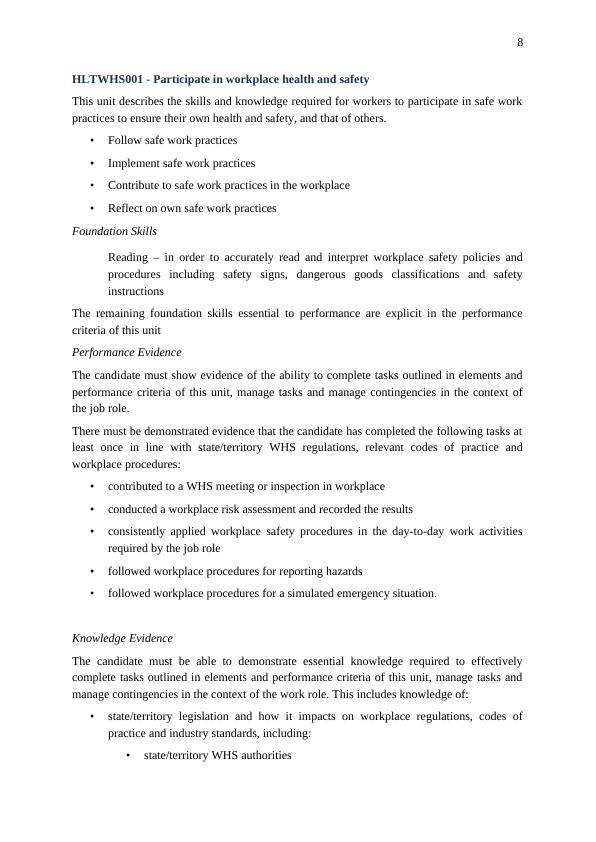
End of preview
Want to access all the pages? Upload your documents or become a member.
Related Documents
Children’s Health and Safety in Early Childhood Education and Carelg...
|151
|24108
|457
Compliant Learning Resources Assessment Workbook 1 CHC30113 Certificate III Versio 3.7 Produced 17 September 2018lg...
|157
|30772
|380
CHC30113 Certificate III In Early Childhood Education And Care - Assessment 1lg...
|164
|33081
|31
Compliant Learning Resources (CHC30113 Certificate III in Early Childhood Education and Care Children’s Health and Safety V3.0 Produced 9 August 2016lg...
|141
|16852
|260
Children’s Health and Safety Assessment Workbook 1 for CHC50113lg...
|131
|17600
|166
Assessment Workbook-1: CHC30113 Certificate III in Early Childhoodlg...
|134
|20661
|26
